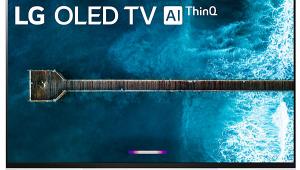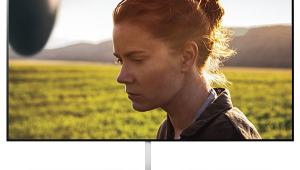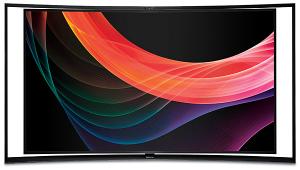As someone said at CNET when they reviewed this TV " 4K is just putting new tires on an old car. OLED is a whole new car. After owning 2 plasmas LED may be brighter but hardly the same picture quality. OLED solves the brightness problem and has an even better picture. Let's hope it sticks around.
LG 55EC9300 3D OLED HDTV Page 2
It was no surprise, however, that this OLED earns its price, and then some, in black level and shadow detail. It’s no secret by now that we’re passionate about these qualities here at Sound & Vision, with good reason. Black is the foundation of every image, either bright or dark, and while you can get away with poor blacks on bright images (which is why animation is used so often in video demos), there’s nowhere to hide in the dark scenes that dominate so many of today’s films. Blacks and contrast are the story there—and in that, the LG 55EC9300 delivers. Does it ever!
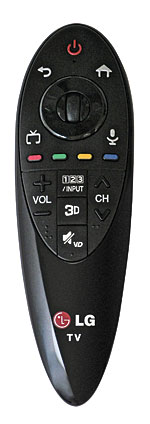 I noticed this immediately in the inky blacks that back up the onscreen logos and the screensaver on Oppo Blu-ray players, and later in the black bars on 2.40:1 films. The best plasmas can equal the latter performance on a bright scene; your pupils close down, making it harder to see any remaining light in the black bars. On dark scenes, however, you can still just make out the black bars on state-of-the-art plasmas like the Pioneer Kuros and the Panasonic TC-65ZT60. But on the LG OLED, they’re gone, period, whatever the brightness level of the image. LCD sets with a full LED array and backlit local dimming can do reasonably well at this, but there are always dark scenes that occasionally reveal the clever trick that local dimming, effective though it can be, actually is.
I noticed this immediately in the inky blacks that back up the onscreen logos and the screensaver on Oppo Blu-ray players, and later in the black bars on 2.40:1 films. The best plasmas can equal the latter performance on a bright scene; your pupils close down, making it harder to see any remaining light in the black bars. On dark scenes, however, you can still just make out the black bars on state-of-the-art plasmas like the Pioneer Kuros and the Panasonic TC-65ZT60. But on the LG OLED, they’re gone, period, whatever the brightness level of the image. LCD sets with a full LED array and backlit local dimming can do reasonably well at this, but there are always dark scenes that occasionally reveal the clever trick that local dimming, effective though it can be, actually is.
My favorite torture-test scenes from Harry Potter and the Deathly Hallows: Part 2 and Prometheus brilliantly demonstrated OLED’s competence at black level and shadow detail. In chapter 10 of Prometheus, for example, a scene in the alien caves begins almost totally black. As the humans enter, the gloom around them remains unchanged, with only the glow of their flashlights growing as they move forward. Another good example was the download waiting symbol on an online site—I believe it was Amazon Instant Video. It’s a small, rotating circle of light, surrounded by blackness both outside and inside. Not only is the darkness around the light totally black on the LG, so is the darkness inside, an area of little more than a square inch. The bright circle doesn’t cause the interior black to be washed out to gray with blooming, as it would be on a local-dimming set.
On the LG 55EA9800 I reviewed last spring, I noticed that the darkest grays on full-field test patterns showed considerable non-uniformity. That wasn’t the case here. If I looked closely, I could see some very subtle geometric shadows in the gray field (under 20 percent peak white), suggesting either some subtle non-uniformity or (gulp) burn-in. The jury is currently out as to whether OLED is sensitive to image retention or burn-in, but until the votes are in, I suggest a little caution—at least as much as you would employ with a plasma until you have 200 hours or so on the set. (I ran the LG for about 100 hours with normal program material before doing any of the tests discussed here.) That’s particularly important with 3D, a format that requires a much higher brightness on the screen to compensate for the loss through the 3D glasses.
Speaking of 3D…
I did all of my 3D watching in the Cinema mode via the default Warm2 color temperature setting, without a 3D color calibration. As discussed, the set uses passive 3D glasses, which generally allow for higher 3D brightness than active glasses. Passive glasses are also cheap to replace and tend to minimize ghosting (3D crosstalk). I saw a bit of the latter on the opening title for Despicable Me, but little or none elsewhere on that film or on other 3D content that is known to be sometimes prone to 3D ghosts. But passive 3D on a 1080p set does cut the vertical resolution in half and adds closely spaced horizontal lines that separate the left- and right-eye images, and which might be visible depending on how far you sit from the set. I sat about 8 feet away, and while I did see the lines, I could easily ignore them.
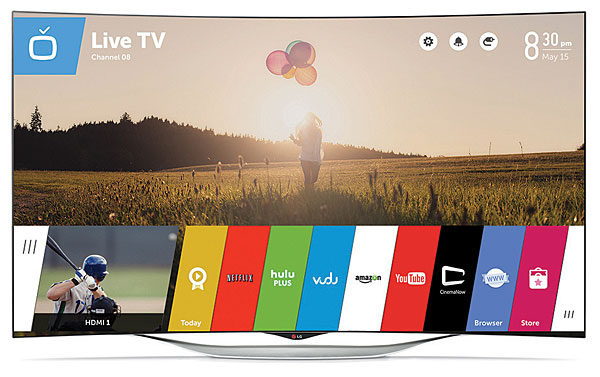
As usual, the loss of vertical resolution in 3D with passive glasses didn’t bother me much—though it might if I was a user who was passionate about 3D, rather than a casual 3D watcher. Passive-glasses 3D really comes into its own on a 4K set, which, unlike this one, will retain a full 1080p vertical resolution to each eye and nullify those horizontal black lines. Home 3D hasn’t turned out to be the video bling of the decade; that honor goes to 4K in 2D. But 3D is still important to some viewers, and if it’s your thing, the LG will likely scratch your 3D itch as effectively as any other set of equal size.
Conclusions
This is where I’d normally compare a set with one of my resident plasmas. But there was no need. The OLED may be smaller, but it can beat the blacks of any plasma ever sold—and it can equal or exceed plasma in other ways as well (except, perhaps, in motion blur, where plasmas will still have a marginal edge).
Still, no set is perfect. But the LG is about as close to it as I suspect we’re going to get in a relatively affordable HDTV for the near future. Yes, there are still some open questions. How long will an OLED panel live and prosper? Is its susceptibility to image retention (or, more seriously, permanent burn-in) acceptably low? Will we see screens larger than 55 inches in 4K OLED sets for under $5,000 any time soon? Can OLED do the wider color gamut that the Ultra HD specs will eventually offer? Does it have any future in the HDR (High Dynamic Range) video that’s coming soon and will require much higher peak-brightness levels than today’s sets?
Who can say? But for the here and now, if you want a set that will make today’s 2K Full HD sources look as good as they possibly can, and you don’t mind what is a relatively small screen in today’s market (and you can manage the price, which, for that screen’s size, is premium but still attainable), you won’t do better than LG’s 55EC9300.
- Log in or register to post comments

I have this TV on my showroom and let me say the picture is wonderful. The contrast is simply amazing. My only issue really is LG did not make the TV VESA compliant for wall mounting. You have to buy there fixed mount for the TV Which has swayed several customers away from buying. I also feel the TV has a very soft picture and almost seems just ever so slightly out of focus sometimes. Thats a personal prefference i believe tho. I have sold TV's and Home Theater for 15 years now and this TV is by far the Best picture ever! I am also predicting LG to takeover as the #1 TV brand because of OLED and samsung will have to take the backseat for now.

Thomas thank you for great reviews on both TVs. I want to ask you for your opinion on the matter of buying a new TV in upcoming months...
I have to buy TV this year because I don't have one (I'm still living with my parents) so I can't wait for 4k OLEDs to come down to a reasonable price (maybe late 2016?).
But I can't really decide whether these perfect blacks and contrast are more important for 'immersion' than more inches of diagonal.... I'm thinking about something like 65" HU7500 samsung... I know its blacks are worse then OLED, but I don't think they are really bad or something are they? Because I have a feeling that 55 inches is not that large (my viewing distance will be about 2.8m) and I don't know whether these super blacks will compensate enough for that smaller diagonal. This cannot be decided in a shop, because there is bright environment so I just have to believe others who have more experience with these sets.
What is your opinion, is the OLED that much better experience that it is OK to sacrifice quite significantly larger picture frame for that? I want this TV to last 5+ years (so maybe 4k ready for HFR can be usefull?)...
Thank you very much in advance.

I have read articles reviewing the LG 55EC9300 and I've visited several showrooms to view this TV. The picture really stands out...blacks are amazing...colors are stunning. The price has been lowered to $2999.99 among competitors, making this beautiful set more appealing. I'm very excited about the OLED technology. However, yesterday I realized it's not quite ready. I observed the dreaded burn-in on a display model. I could clearly read the word "SETUP" burned-in to the display in a band across the lower portion of the screen.
I bought a different brand of 4K UHDTV.
Your reviews and are extremely helpful. I also appreciate your "HOW TO" section. Thank you.



